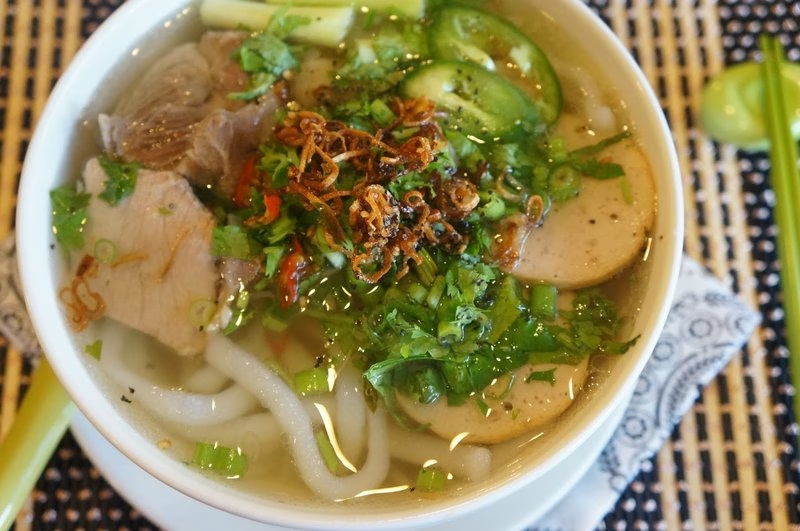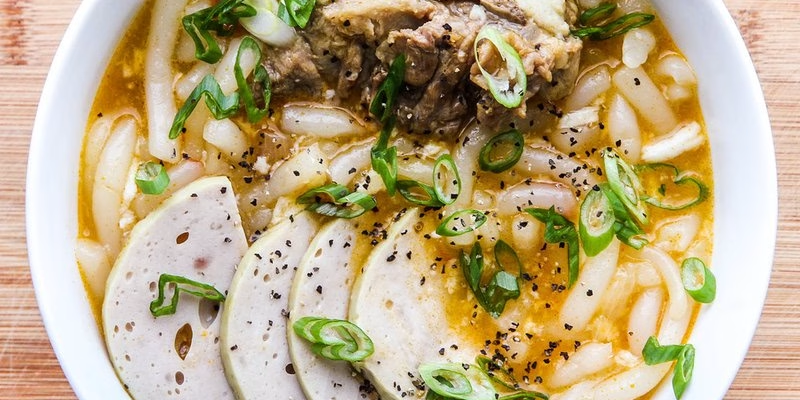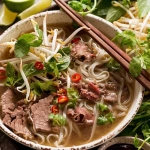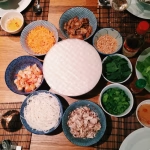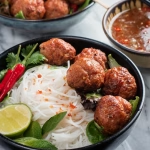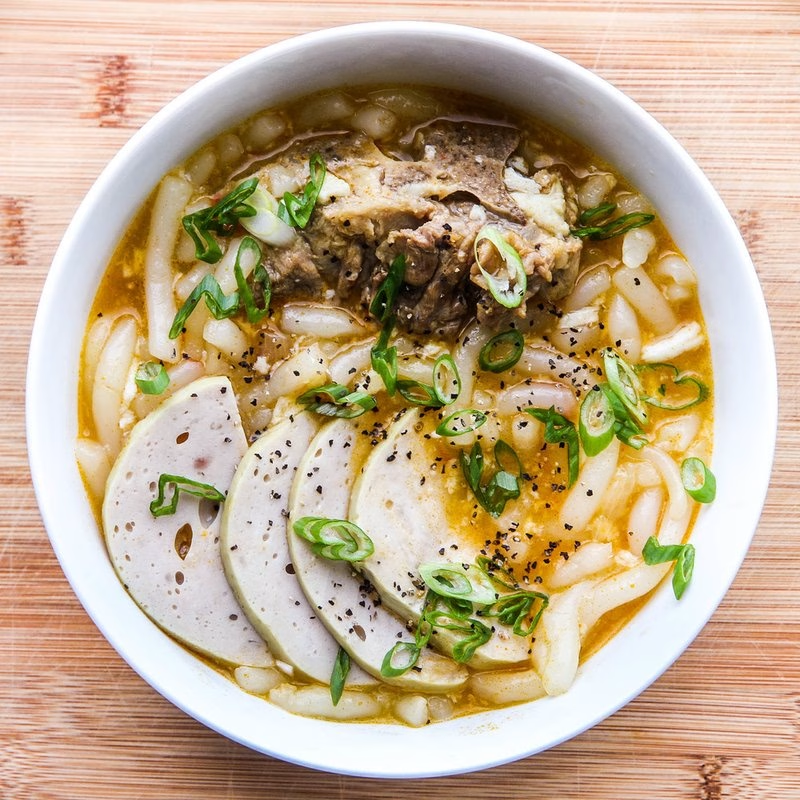
Are you ready to embark on a culinary journey to Vietnam? Banh Canh (Udon Noodle Soup) is one of those dishes that can warm your soul, no matter how chilly it is outside. This delightful noodle soup features thick, chewy udon-like noodles swimming in a rich, savory broth that is often paired with an array of proteins and fresh herbs. Originating from the Southern regions of Vietnam, Banh Canh offers a unique blend of flavors and textures that make it a popular choice among locals and food enthusiasts alike.
In this article, you’ll discover the essential Banh Canh (Udon Noodle Soup) ingredients, different Banh Canh (Udon Noodle Soup) variations, and step-by-step instructions on how to make this comforting dish at home. Whether you’re a seasoned cook or a beginner looking to impress, you’ll be armed with everything you need to savor this Vietnamese favorite!
Ingredients
| Ingredient | Measurement | Description |
|---|---|---|
| Banh Canh noodles | 300g | These thick, chewy noodles are the star of Banh Canh, giving it its hearty texture. |
| Pork or shrimp | 250g | Protein options include tender pork slices or succulent shrimp, both adding depth to the soup. |
| Chicken broth | 1 liter | A rich broth serves as the base, infusing the soup with flavor and warmth. |
| Garlic | 4 cloves, minced | Fresh garlic enhances the aroma and depth of flavor in Banh Canh. |
| Onion | 1, chopped | Onion adds sweetness and complexity to the broth. |
| Fish sauce | 2 tbsp | The key ingredient for that umami taste that’s essential in Vietnamese cuisine. |
| Green onions | 2, sliced | These add a fresh touch and beautiful garnish to your soup. |
| Cilantro | 1/4 cup, chopped | A fresh herb that elevates the dish and adds a pop of color. |
| Chili peppers | 1, sliced (optional) | For those who like a spicy kick! |
Step-by-Step Instructions
- Prepare the Ingredients: Start by chopping your fresh vegetables, including onions and green onions. If you’re using pork or shrimp, slice the pork thinly or peel and devein the shrimp for the best texture in your Banh Canh (Udon Noodle Soup).
- Cook the Base: Heat a tablespoon of oil in a large pot over medium heat. Sauté the chopped onion and minced garlic until they are golden brown, which will create a fragrant base for your broth. This step is crucial for achieving that authentic taste.
- Add the Broth: Pour in the chicken broth and bring it to a gentle simmer. Add in the fish sauce, which will give your soup that signature savory depth that defines Banh Canh (Udon Noodle Soup).
- Cook the Proteins: If you’re using pork, add it now and let it cook until it’s tender. If you’re using shrimp, add them a few minutes later—they cook quickly and should be added just before serving.
- Prepare the Noodles: Cook the Banh Canh noodles according to package instructions. Drain and set aside. Make sure not to overcook them; they should maintain a nice chewiness.
- Combine and Serve: In bowls, layer the cooked noodles, then pour over the hot broth and protein. Top each bowl with sliced green onions, chopped cilantro, and chili peppers if you like a bit of heat. Serve your Banh Canh (Udon Noodle Soup) hot and enjoy the comforting flavors!
Pro Tips
- Make Your Own Broth: For a richer flavor, consider making your own chicken broth a day ahead. This can take your Banh Canh (Udon Noodle Soup) to the next level!
- Texture Matters: Be sure not to overcook your noodles. They should be al dente to hold their shape well in the soup.
- Experiment: Try using different proteins or adding vegetables like bok choy or mushrooms for extra flavor and texture.
- Serve with Sides: A side of lime wedges and fresh herbs can enhance the dish further when served, allowing everyone to customize their soup.
Nutritional Information
| Nutrient | Per Serving |
|---|---|
| Calories | 350 |
| Protein | 20g |
| Carbs | 45g |
| Saturated Fats | 3g |
| Fiber | 2g |
| Cholesterol | 60mg |
| Sugars | 2g |
| Fat | 10g |
FAQs
What is the best way to store Banh Canh (Udon Noodle Soup)?
Store the soup in an airtight container in the fridge for up to three days. It’s best to keep the noodles separate to prevent them from getting mushy.
Can Banh Canh (Udon Noodle Soup) be made vegan or gluten-free?
Yes! Use vegetable broth and substitute the protein with tofu or a variety of veggies. For gluten-free, make sure to use gluten-free noodles.
What are the best side dishes to serve with Banh Canh (Udon Noodle Soup)?
Fresh spring rolls or a light salad with a citrus dressing pairs wonderfully with this soup.
How long does it take to prepare Banh Canh (Udon Noodle Soup)?
From start to finish, you can make this delicious soup in about 45 minutes, including prep and cooking time.
Can I freeze Banh Canh (Udon Noodle Soup) for later?
It’s best to freeze the broth and noodles separately to maintain texture. The broth can be frozen for up to three months.
What other proteins can I add to Banh Canh (Udon Noodle Soup)?
You can experiment with other proteins like beef, fish, or even dumplings for added variety.
Can I add more vegetables to Banh Canh (Udon Noodle Soup)?
Absolutely! Carrots, bok choy, or mushrooms are great additions that provide both flavor and nourishment.
Is Banh Canh (Udon Noodle Soup) spicy? How can I adjust the heat?
The soup is not inherently spicy, but you can adjust heat levels by adding more chili peppers or using a spicy fish sauce.
There you have it—your guide to making delicious Banh Canh (Udon Noodle Soup) at home! With its delightful flavors and warm broth, this dish is sure to become a staple in your kitchen. Don’t hesitate to experiment with different ingredients and variations. Whether it’s a cozy family dinner or a gathering with friends, this soup is a surefire hit.
Tried this Banh Canh (Udon Noodle Soup) recipe? Let us know your experience in the comments below!
